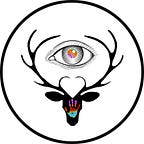Following the Light
How a Brush with Death led to a Creative Life
This week I’m talking to my friend and Los Angeles visionary painter, Robert Soffian. I’ve known Robert for years and have always enjoyed his dry wit and interesting philosophical views about life and art.
He has been a poet, performance artist, creative lighting director, theatrical director, filmmaker, teacher, and painter. Under all of these hats runs a through-line of exploration: seeking new ways to communicate universal themes about life, death, spirit, and existence through art.
Robert grew up in New York City, hanging out with the kids of artists like Jack Levine, William Burroughs, and Leon Golub. This bohemian upbringing had already laid the foundation for a very creative and unusual life, but I soon discovered this was only part of his story. I asked Robert to share something that happened to him that influenced his current forms of creative expression. The following narrative caught me completely by surprise.
When Robert was little he suffered from chronic asthma and recurrent bouts of tonsilitis. At the age of 7, he experienced a particularly severe case of tonsilitis which required immediate medical attention. He was rushed to a hospital where emergency surgery was performed. However, something awful happened. When Robert woke up from the anesthesia he couldn’t stop coughing up blood. The surgeon had nicked the main blood vessel in his throat.
Little Robert lost a lot of blood and soon went into shock after which he lapsed into a coma. His parents were told he might not recover, and they spent the next several harrowing hours not knowing if their son would live or die. He spent the night getting transfusions as nurses came in and out of his room to check his vitals.
As Robert recalls this episode, he says he was fully aware of his surroundings but felt no pain or fear. Instead, he felt a “blissful ascension” sensing his body rising from the bed towards the ceiling. Pausing to look down, he saw his inert form attached to machines and transfusion lines in the empty room. As he rose again he saw a bright light. It gave him an immeasurable feeling of happiness and acceptance. On the verge of entering this light, his floating body began to shimmer. Just then a booming voice called, “Go Back!” telling him it was not his time. Though he was reluctant to turn away from the inviting light, his wispy spirit drifted back down to rejoin his physical self on the hospital bed, where he woke up.
The room was dark, and he knew the bleeding had stopped. A nurse came into the room for her rounds and found him conscious and sitting up. She rushed out to tell the doctors that he was alive.
A couple of days later he was released from the hospital with a crutch and a fresh scar on his ankle from the tubes. He never told his family about the experience of that night, but that event made Robert aware of a hermetic world just outside our waking reality. He felt there must be something he was meant to accomplish, and he set out to find it.
Throughout his life, Robert has investigated all of the scientific and medical reasons that might have caused his near-death experience so many years ago. But, whatever the cause, this psychic or mystical vision revealed a truth he has carried with him ever since: the world contains esoteric mysteries that exist beyond our five senses. Some people might have been intimidated by this knowledge or dived headfirst into a monk’s life. Instead, this otherworldly event opened Robert up to new ways of seeing, giving him boundless confidence to make any kind of eccentric art that captures his imagination.
As you will see from the photos, color plays a dominant role in Robert’s paintings. When I asked him about that he explained his fascination with the physics of color, and how it relates to our experience of reality. Color is perceived when cells in our retinas are activated by wavelengths of light. When this happens, our limbic system, the primordial part of our brains that tries to make sense of reality, is stimulated. Our limbic logic tells us, “red is red.” If I see red, and you also see red, we can assume we are both experiencing the same color. But as we know, if we ask “what is red” in a crowded room, we will get a lot of different answers. Each person processes light wavelengths uniquely. So, which of our reds, or realities, is really real?
This brings us back to the story of Robert’s young spirit rising towards the light in that long-ago hospital room. Was that real? Was it imagination? Or something else? Robert’s paintings invite us to ponder the dream-like experience of that boy’s metaphysical journey, challenging us to examine our closely held perceptions of reality.
“Art making can be a sacrificial, lonely exercise. Developing confidence in your path is essential. One needs to relax self-judgment and doubt to discover the best possible way to say what you must. Having faith, especially in yourself, is a wonderful weapon against the darkness of irrelevance which society often ascribes to creative expression.” ~ Robert Soffian
Like and follow Robert at these links:
IG: @RobertSoffianArt
Website: RobertSoffian.com
###
